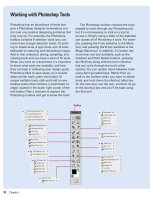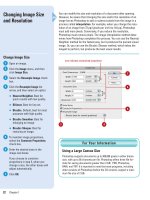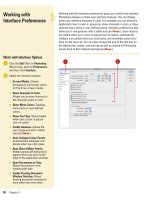Photoshop cs5 by steve Johnson part 29 ppsx
Bạn đang xem bản rút gọn của tài liệu. Xem và tải ngay bản đầy đủ của tài liệu tại đây (917 KB, 6 trang )
ptg
Chapter 8 Understanding Colors and Channels 181
The CMYK color mode is the color mode of paper and press. Printing
presses (sometimes referred to as a 4-color press) convert an image's
colors into percentages of CMYK (Cyan, Magenta, Yellow, and Black),
which eventually become the color plates on the press. One at a time,
the plates apply color to a sheet of paper, and when all 4 colors have
been applied, the paper contains an image similar to the CMYK image
created in Photoshop. The CMYK color mode can take an image from a
computer monitor to a printed document. Before converting an image
into the CMYK mode, however, it's important to understand that you
will lose some color saturation during the conversion. The colors that
will not print are defined as being out of gamut. To view the areas of an
RGB image that will lose saturation values, click the View menu, and
then click Gamut Warning. Photoshop will mask all the areas of the
image that are out of gamut.
Understanding the
CMYK Color Mode
Convert an Image to CMYK Color
Open an image.
Click the Image menu, point to
Mode, and then click CMYK Color.
Photoshop converts the image
into the CMYK color mode.
2
1
CMYK color
mode
1
See Also
See “Using Curves and Color
Adjustments” on page 200 for more
information on adjusting the color of an
image.
From the Library of Wow! eBook
ptg
182 Chapter 8
The Grayscale color mode utilizes an 8-bit pixel (8 on/off light switches)
to generate 1 black, 1 white, and 254 shades of gray. Although scanning
and working on old black and white images might seem the obvious
reason to use the Grayscale color mode, the speed and power of
Photoshop, combined with faster computer systems, has prompted
most photo restorers to switch to the RGB color space because of its
greater versatility and ability to generate millions of colors (or shades
of gray). Yet despite the move to RGB, the Grayscale color mode is still
used extensively with black and white images, where file size is a con-
sideration (grayscale images are two-thirds smaller than RGB images),
and when output to rag-style papers, such as newsprint, fail to produce
the detailed information available with RGB.
Understanding the
Grayscale Color Mode
Convert an Image to Grayscale
Open an image.
Click the Image menu, point to
Mode, and then click Grayscale.
The image is automatically
converted into the Grayscale color
mode.
2
1
Grayscale
color mode
1
Did You Know?
You can colorize a grayscale image.
Convert the image into the RGB mode,
and then select a color, brush, and
brush size on the Options bar. The trick
is to change the blending mode of the
brush on the Options bar to Color.
Then, as you paint on the image, the
selected color will replace the original
grays.
Colorizing a Grayscale Image
If you're planning on colorizing a grayscale image, you can increase
your control of the image by creating a layer directly above the
image layer, and painting in the new layer. Leave the blending mode
of the brush at Normal and change the blending mode of the new
layer to Color. When you paint, the color is applied and controlled in
the new layer, and you have the additional option of using layer
opacity to control the intensity of the effect.
For Your Information
From the Library of Wow! eBook
ptg
Chapter 8 Understanding Colors and Channels 183
Bitmap images consist of two colors: black and white. Bitmap images
are sometimes referred to as 1-bit images. Think of a bitmap as a light
switch with two positions, on and off. Each pixel in a bitmap image is
either on or off, black or white. Because they are only 1 bit, the file size
of a bitmap image is typically very small. Bitmap images have limited
use, but often are employed for black and white ink drawings, line art,
sketches, and for creating halftone screens.
Understanding the
Bitmap Color Mode
Convert an Image to Bitmap
Open an image.
Click the Image menu, point to
Mode, and then click Bitmap.
IMPORTANT
Before converting
an image into a bitmap, it must first
be in the Grayscale color mode.
Enter a value for Output Resolution.
Click the Use list arrow, and then
select from the available options:
◆ 50% Threshold. Converts pixels
with gray values above the middle
gray level (128) to white and
below to black. The result is a
high-contrast, black-and-white
image.
◆ Pattern Dither. Converts an image
by organizing the gray levels into
geometric patterns of black and
white dots.
◆ Diffusion Dither. Converts pixels
with gray values above the middle
gray level (128) to white and
below to black using an error-
diffusion process. The result is a
grainy, film-like texture.
◆ Halftone Screen. Simulates the
effect of printing a grayscale
image through a halftone screen.
◆ Custom Pattern. Simulates the
effect of printing a grayscale
image through a custom halftone
screen. This method lets you
apply a screen texture, such as a
wood grain, to an image.
Click OK.
5
4
3
2
1
5
3
4
Bitmap color
mode
50% Threshold
Diffusion Dither
From the Library of Wow! eBook
ptg
184 Chapter 8
The Indexed Color mode gives you two advantages. You can create
images as small as grayscale (8-bit pixels), and you get color instead of
shades of gray. Its small file size and ability to generate color make it a
winning color mode for images displayed on web pages, as well as
graphics used in computer-generated presentations. Its one drawback
is the number of colors generated; Indexed Color images generate a
maximum of 256 colors (the same number as the steps of gray in a
grayscale image). The good news is that you get to choose the colors.
When you convert an image into the Indexed Color mode, Photoshop
creates a color lookup table (CLUT) to store the image's color informa-
tion. When a color in the image cannot be found in the lookup table,
Photoshop substitutes the closest available color.
Understanding the
Indexed Color Mode
Convert an Image to
Indexed Color
Open an image.
Click the Image menu, point to
Mode, and then click Indexed
Color.
Select from the following Indexed
Color Mode options:
◆ Palette. Click the list arrow to
choose from the available color
panels, or click Custom and
create your own palette.
◆ Colors. Select the number of
colors for the lookup table (9 to
256).
◆ Forced. Force the lookup table
to hold specific colors. Black
and White adds a pure black
and a pure white to the color
table; Primaries adds red,
green, blue, cyan, magenta,
yellow, black, and white; Web
adds the 216 web-safe colors;
and Custom allows you to
specify your own colors.
◆ Transparency. Select the check
box to preserve transparent
areas of the image (if there are
no transparent areas, this
option is disabled).
3
2
1
3
From the Library of Wow! eBook
ptg
Chapter 8 Understanding Colors and Channels 185
Select from the following options:
◆ Matte. Click the list arrow to fill
transparent areas of the
original image with a specific
color.
◆ Dither. Click the list arrow, and
then select a pixel-mixing
(dither) scheme. Dithering helps
transitional areas of the image
(shadows, light to dark) appear
more natural.
◆ Amount. If the Dither option is
selected, the Amount instructs
Photoshop how much color
information to use in the
dithering process (0% to 100%).
◆ Preserve Exact Colors. Select
the check box to hold exact
color measurements in the
lookup table.
Click OK.
5
4
5
4
Indexed color image
Indexed color
mode
From the Library of Wow! eBook
ptg
186 Chapter 8
The Lab color mode is an old color measuring system. Created in
France, its purpose was to measure color based on visual perception.
Since personal computers had not been created at that time, the Lab
mode is not based on a particular computer or operating system, and
so Lab color is device independent. The Lab mode measures color
using a lightness channel, an "a" channel (red to green), and a "b" chan-
nel (blue to yellow). Lab Color works well for editing images obtained
from Photo CDs or DVDs, moving images between operating systems
(Photoshop Mac to Photoshop Win), and for printing color images to
PostScript Level 2 or 3 devices. Because of its ability to separate the
gray tones of an image into an individual channel (lightness), the Lab
color mode is excellent for sharpening, or increasing the contrast of an
image without changing its colors. Just convert the original RGB image
to Lab color, select the Lightness channel, and perform sharpening or
Levels and Curves adjustments directly to the channel.
Understanding the
Lab Color Mode
Convert an Image to Lab Color
Open an image.
Click the Image menu, point to
Mode, and then click Lab Color.
Photoshop converts the image
into the Lab color mode.
2
1
1
Lab color
mode
Did You Know?
You can use the Lab color mode
to archive RGB color images.
Since the Lab color space is device-
independent, and RGB is device-
dependent, archiving RGB images in
the Lab color mode stabilizes the
image's color information and insures
color accuracy, no matter what editing
application is used.
From the Library of Wow! eBook









